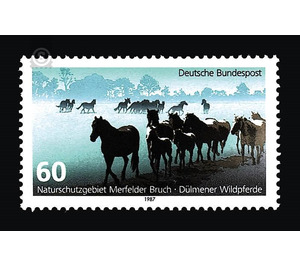Nature and environmental protection - Germany / Federal Republic of Germany 1987 - 60 Pfennig
Theme: Animals
| Country | Germany / Federal Republic of Germany |
| Issue Date | 1987 |
| Face Value | 60.00 |
| Color | multi-colored brown green blue |
| Perforation | K 14 |
| Printing Type | 4-color rotogravure |
| Stamp Type | Postage stamp |
| Item Type | Stamp |
| Chronological Issue Number | 1201 |
| Chronological Chapter | GER-BRD |
| SID | 179514 |
| In 48 Wishlists | |
The Deutsche Bundespost is continuing its series of »Nature and Environmental Protection« in the »European Environmental Year 1987« with the »Dülmener Wildpferden« in the Merfelder Bruch nature reserve. The stamp is intended to help bring the unique wild horse reserve to the general public. The fractures of Westphalia were since primeval times an ideal refuge for the game, as well as for wild horses, which were considered to be an exquisite hunting game until the early Middle Ages. In 1316, the Herr von Merfeld secured not only fishing and hunting but also the right to the wild horses in Merfelder Bruch. Anno 1840 the Merfelder break was divided due to the law for the regulation of the landlordly and peasant enterprises. The then Duke of Croy fell to about 1,900 Prussian morning. This area has been expanded over time to about 3,000 acres. In the midst of this property is now the real wilderness with about 800 Prussian acres or about 200 acres. There live on a long-term average 170 to 200 horses. They are called wild horses, but in the zoological sense they are not pure wild horses, because over time they have repeatedly mixed with domestic horses. On the other hand, they are very close to the wild horses, because they are subjected to a very hard selection by nature, because they know in contrast to our domestic horses, a stable that protects them from the rigors of the weather and get in winter only so much hay, that they are just getting by. In terms of survival, the months of February and March are the hardest time of the wet cold. The housing conditions have created a horse whose importance is far greater than regional. Because of this extensive so-called "primitive attitude", valuable genetic material from the wild horse period has been preserved. Especially since it has been recognized that the special peculiarity of these animals is best preserved if one does not always introduce foreign hereditary factors into the herd by using stallions of other breeds. Twenty years ago, Polish conik stallions began to be used for breeding, a breed that originated from a habitat that has similar conditions to the Merfelder Bruch. In the meantime, it has become so far that the sons of these Koniks from Dülmen mares have optimal conditions for the survival of the herd. Why is such a herd of supraregional importance? Animal breeders around the world have come to realize that the conservation of so-called primitive breeds, which are threatened with extinction, will become very important to the future of our domestic breeds if the breeding progress reaches too great a constriction of the gene pool, ie the totality of heredity Has. Then a pet breed can be rehabilitated with the help of such original genetic material. It is thanks to the Duke of Croy, who takes the effort and expense to preserve this reserve, so that today in the Merfelder Bruch is a unique living relic from the Middle Ages and that annually many thousands of visitors to this natural monument can enjoy. (Text: Dr. Klaus Zeeb, Animal Hygiene Institute Freiburg)


